
Dimdima
Online Children's Magazine from India

Dimdima
Online Children's Magazine from India
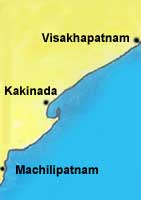
Northeast of Machilipatnam lies the delta formed by the river Godavari, the longest river in the south and often referred to as the Dakshina Ganga. The French-speaking town of Yanam is situated at the northeastern end of this delta.
Yanam is a small town barely 34sq km in area. It was a French possession for a long time and now is part of the Union Territory of Pondicherry.
Further north is the coastal village of Sarpapuram, the town of snakes. The Bhavanarayanswami temple here is well-known.
According to legend, the mother of Anantha, the king of snakes, was once so angry with the snakes that she uttered a terrible curse. As a result, all of them perished in a sacrificial fire. Anantha was away on a pilgrimage at the time. He was extremely distressed to hear about 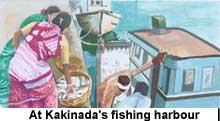 what had happened when he returned. He prayed to Lord Vishnu and practised severe penance so that his snakes would be restored to life. Vishnu appeared to him in answer to his prayers and the Lord looked exactly as Anantha had imagined him to be. Later when he built a temple at the spot, the idol was made to resemble this form of Vishnu and the temple came to be known as Bhavanarayanaswamy , meaning the 'thought form' of Vishnu.
what had happened when he returned. He prayed to Lord Vishnu and practised severe penance so that his snakes would be restored to life. Vishnu appeared to him in answer to his prayers and the Lord looked exactly as Anantha had imagined him to be. Later when he built a temple at the spot, the idol was made to resemble this form of Vishnu and the temple came to be known as Bhavanarayanaswamy , meaning the 'thought form' of Vishnu.
A few kilometres further north takes us to Kakinada. A minor port, it exports cotton. groundnuts, sugar and tobacco.
In 1923, a historic session of the Indian National Congress took place here under the presidentship of Maulana Mohammed Ali, the first Khilafat leader.
Draksharama is a coastal town 17km from Kakinada. Its name is believed to be a corrupted form of Daksha Arama or the garden af Dakshaprajapati, site of a famous yagna.
According to legend, Dakshaprajapati's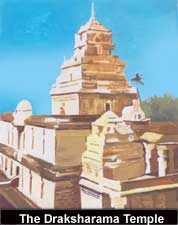 daughter Dakshayani got married to Siva much against her father's wishes.
daughter Dakshayani got married to Siva much against her father's wishes.
When Dakshaprajapati performed his grand yagna he deliberately did not invite Siva. But Dakshayani was keen on attending her fathers yagna and so she went there alone. Not only was she ignored by her father but she also had to suffer insults flung at her and her husband even though he was not present. Thoroughly humiliated she threw herself into the yagna fire. When Siva heard this, he was so furious that he began to sweat profusely. Out of this sweat was born the ferocious monster, Veerabhadra, who avenged his master by killing Dakshprajapati.
The Draksharama temple is said to have inspired the 14th century poet, Srinatha, to write the Bhimakhanda, a long piece of Telugu poetry. Original writing in Telugu literature is said to have begun with him.
Interestingly, there is a tomb of the Muslim saint, Sayid Shah Bhaji Aulia, and a mosque in the compound of the Siva temple here.
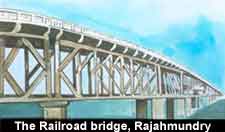 Rajahmundry (Rajamahendravaram) is located on the banks of the Godavari, west of Kakinada. It is noted for its carpets and sandalwood products. The 56-span long bridge here is the second largest in India. Rajahmundry is also associated with poet Nannaya, who wrote the first Telugu classic, the Andhra Mahabharatamu.
Rajahmundry (Rajamahendravaram) is located on the banks of the Godavari, west of Kakinada. It is noted for its carpets and sandalwood products. The 56-span long bridge here is the second largest in India. Rajahmundry is also associated with poet Nannaya, who wrote the first Telugu classic, the Andhra Mahabharatamu.
Our journey along the coastal road takesus to Visakhapatnam, the biggest and the deepest port between Rotterdam in the West and Tokyo in the East.Visakhapatnam was named after Vaisakha, the God of Valour, whose temple once stood by the shore. It used to be a small fishing village till the 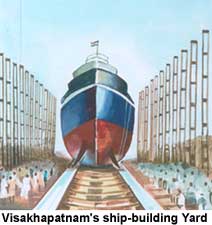 British transformed it into a seaport. Today, Visakhapatnam is a bustling, industrial city with the largest ship-building yard in the country - the Hindustan Shipyard Ltd., established in 1952.
British transformed it into a seaport. Today, Visakhapatnam is a bustling, industrial city with the largest ship-building yard in the country - the Hindustan Shipyard Ltd., established in 1952.
The city's famous landmark is the Dolphin's Nose, a 358m high rock that juts into the sea. It resembles a dolphin's nose. On top of this huge rock is a lighthouse, whose beam can be seen 65km out at sea. It is the country's most powerful lighthouse.
Waltair, often referred to as Visakhapatnam's twin town, is barely three kilometres away. Its pleasant climate has made it a health resort. The three best known beaches of 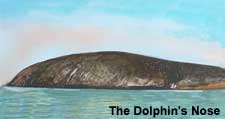 Visakhapatnam, the Ramakrishna Mission Beach, the Rishikonda Beach and Lawson's Bay, are idyllic beaches with vast stretches of golden sand.
Visakhapatnam, the Ramakrishna Mission Beach, the Rishikonda Beach and Lawson's Bay, are idyllic beaches with vast stretches of golden sand.
Simhachalam or the Hill of the Lion stands barely 16km west of Visakhapatnam. A temple dedicated to Lord Narasimha or Vishnu was built on top of the hill in the 11th century.
According to the Puranas, Hiranyakasiputhe king of the Rakshasas was angry with his son, Prahlad, for worshipping Vishnu. Though he tried various ways to make his son stop worshipping Vishnu, he did not succeed. In exasperation, he threw Prahlad into the sea and then placed the Simhachalam hill over his head in order to crush him ,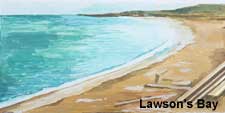 completely. Vishnu was furious. Taking the form of Narasimha,(half man and half lion) he came to Prahlad's rescue. He stood by the side of the hill and tilted it up so that Prahlad could escape. He then went in pursuit of Hiranyakasipu. But even after killing him his anger would not subside and it was only when Lord Siva disguised as the bird 'Sarabha' pacified him that he calmed down.
completely. Vishnu was furious. Taking the form of Narasimha,(half man and half lion) he came to Prahlad's rescue. He stood by the side of the hill and tilted it up so that Prahlad could escape. He then went in pursuit of Hiranyakasipu. But even after killing him his anger would not subside and it was only when Lord Siva disguised as the bird 'Sarabha' pacified him that he calmed down.
To appease the fury of the lord, the idol of Narasimha inside the temple is covered with thick layers of sandalwood paste. The sandalwood coating is removed only once a year during the Chandanyatra festival around April-May, when people from all over the country visit the shrine to have a 'darshan' of the Lord.
Last updated on :8/26/2005
Dimdima is the Sanskrit word for ‘drumbeat’. In olden days, victory in battle was heralded by the beat of drums or any important news to be conveyed to the people used to be accompanied with drumbeats.
Bharatiya Vidya Bhavan
K. M Munshi Marg,
Chowpatty, Mumbai - 400 007
email : editor@dimdima.com
Bharatiya Vidya Bhavan
505, Sane Guruji Marg,
Tardeo, Mumbai - 400 034
email : promo@dimdima.com
Dimdima.com, the Children's Website of Bharatiya Vidya Bhavan launched in 2000 and came out with a Printed version of Dimdima Magazine in 2004. At present the Printed Version have more than 35,000 subscribers from India and Abroad.